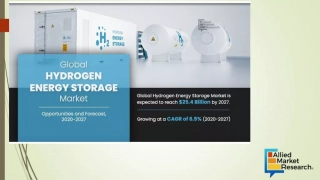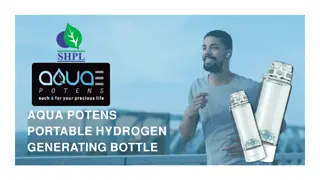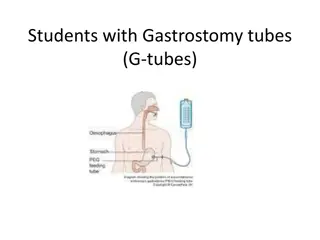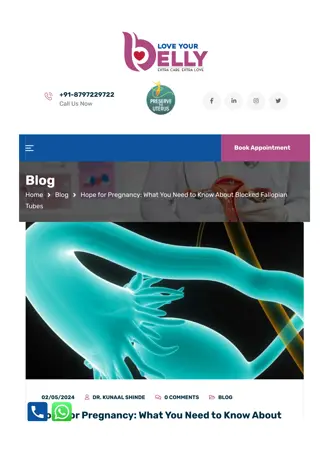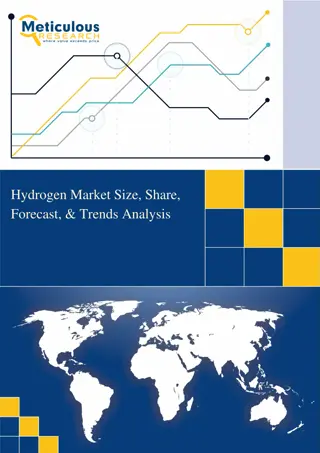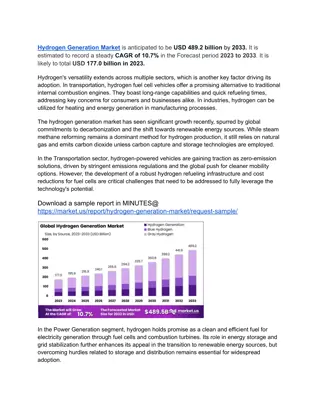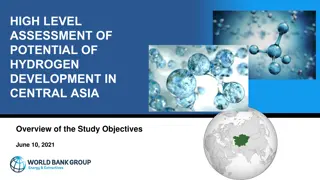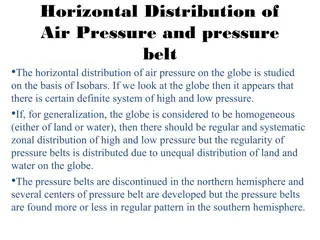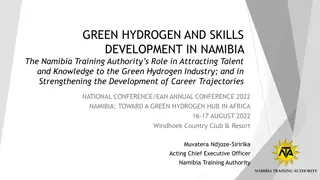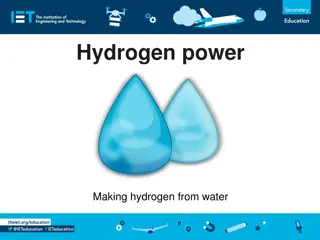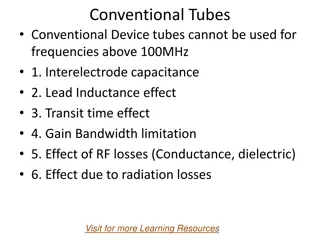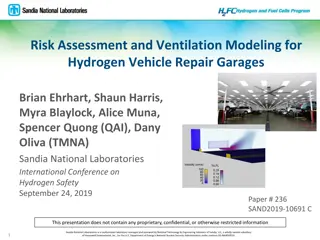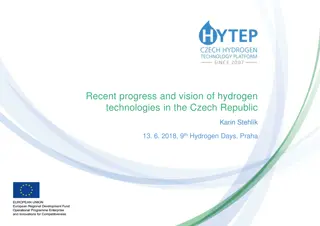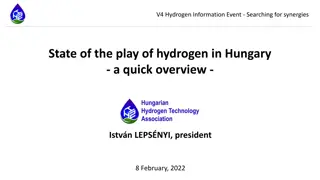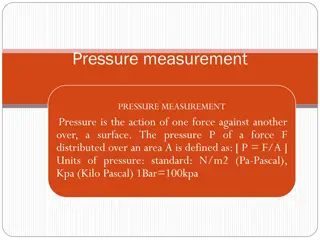Reducing Hydrogen Pickup in CANDU Zr-2.5Nb Pressure Tubes
This study focuses on reducing the hydrogen pickup during the processing of CANDU Zr-2.5Nb pressure tubes. Various stages in the processing are detailed, and the hydrogen concentrations in different reactor sets of pressure tubes made before 1990 are analyzed. The desire is to lower the initial hydrogen concentrations in the tubes to improve their performance and longevity in the reactor environment.
Download Presentation

Please find below an Image/Link to download the presentation.
The content on the website is provided AS IS for your information and personal use only. It may not be sold, licensed, or shared on other websites without obtaining consent from the author.If you encounter any issues during the download, it is possible that the publisher has removed the file from their server.
You are allowed to download the files provided on this website for personal or commercial use, subject to the condition that they are used lawfully. All files are the property of their respective owners.
The content on the website is provided AS IS for your information and personal use only. It may not be sold, licensed, or shared on other websites without obtaining consent from the author.
E N D
Presentation Transcript
CANDU Zr-2.5Nb Pressure Tubes Reducing the hydrogen pickup of new tubes during processing Gerry Moan, Ron Graham and Syd Aldridge
Stages in PT Processing Sponge, alloy & recycle, melted to give final ingot, 23 diameter Hot forged at ~1000 deg C Hot Rotary forged to ~8 diameter Heated to 1000 deg C and quenched Machined into billets ~23 long x ~8 OD x ~4 ID Double steel and Cu can Heated to ~815 deg C and hot extruded Surface preparation for cold drawing; ~25% in 2 draws Autoclaving at 400 deg C for 24 hours
H in PressureTubes Zr alloys contain H, from the sponge & picked up during processing. Specification on H concentration in a pressure tube was 25 ppm max. Many measurements made on old PT from the top or bottom of ingots showed average values for reactor sets of ~10 ppm with std dev 3 ppm.
H concentrations in different reactor sets of pressure tubes made before 1990 Reactor Set 1 2 3 4 5 6 7 8 9 10 11 12 13 14 15 H H H Maximum 15.0 16.5 12.3 14.0 13.2 15.6 14.4 14.6 13.1 16.5 16.7 14.6 20.6 12.6 19.0 Minimum 3.0 4.0 2.3 3.0 3.8 3.4 3.6 4.1 2.9 3.3 3.4 4.2 3.5 3.5 3.7 Average 7.7 8.7 6.5 6.4 7.3 7.3 7.9 8.0 7.4 7.3 8.9 9.0 8.8 7.9 9.4 Maximum Minimum Average 20.6 12.3 15.2 4.2 2.3 3.4 9.4 6.4 7.9 All values in ppm
Variation in Average H Concentrations in Reactor Sets of Pressure Tubes made before 1990 with Production Sequence 10.0 Average H Concentration in Reactor Set, 8.5 7.0 ppm 5.5 4.0 1 2 3 4 5 6 7 8 9 10 11 12 13 14 15 Manufacturing Sequence (Oldest to Youngest)
H and D in pressure tubes In reactor the pressure tube inside surface is in contact with hot D2O and it sees a neutron flux. The ID surfaces oxidize : 2D2O + Zr ZrO2+ 4D The ZrO2forms an oxide on the metal surface; about 5% of the D atoms formed enter the metal and oxide. Thus during service, the D concentration increases with service Heq = Hydrogen Equivalent = H initial + 0.5*D picked up (all in ppm)
Desire to have lower H initial concentrations Excessive H and D concentrations are not acceptable in Zr alloy because: High H and D concentrations can lead to poor fracture toughness in service. High H/D + tensile stresses + flaws can lead to the crack formation by Delayed Hydride Cracking (DHC) DHC was involved in PT leaks in Pickering in the 1970s and in Bruce A in the 1980s. No DHC leaks have been seen in normal operation in the last 30 years.
The need to have lower Heq values The Canadian Standards Association and the Regulators impose maximum Heq concentrations 70 ppm Heq at inlet rolled joint and 100 ppm Heq at outlet rolled joint The operators would have to measure the Heq concentrations in pressure tubes in service. When the Heq concentrations approach the maximum allowed values the measurements would become more frequent and more PT would need to be sampled. More detailed models would be required. It would be a benefit to have PT with lower H initial values.
CANDU OWNERS GROUP (COG) COG asked that we examine the H concentrations in pressure tubes and in PT material during processing, to determine which stages contributed the most. Of interest were bulk concentrations and concentrations and gradients at heated surfaces. We collected material from 2 ingots that were used to make ~80 pressure tubes. Material came from all stages from sponge to finished tubes. Some 7000 samples for H analysis were prepared and analysed. Samples for H analysis were closely spaced at corners and at curved surfaces.
Stages in PT Processing Sponge, alloy & recycle, melted to give final ingot, 23 diameter Hot forged at ~1000 deg C Hot Rotary forged to ~8 diameter Heated to 1000 deg C and quenched Machined into billets ~23 long x ~8 OD x ~4 ID Double steel and Cu can Heated to ~815 deg C and hot extruded Surface preparation for cold drawing; ~25% in 2 draws Autoclaving at 400 deg C for 24 hours
Sponge Ingots H concentrations ranged between 13 and 66 ppm Most data were between 4 and 5 ppm Some surface values up to 10-14 ppm Most data between 4 and 5 ppm At forged surfaces some values were 11-40 ppm Average 5 ppm Average 4.3 ppm Billets Extrusions Drawn Tubes Autoclaved Tubes Average 4.8 ppm Summary of ~7000 H analyses on samples from ~80 in-process pressure tubes
Process Changes The results from the H analyses were examined and shared with Wah Chang and with Nu-Tech. We saw where process changes could be made to minimize H pick up.
Process Changes at Wah Chang After Kroll reduction, a vacuum distillation process boils off the MgCl2and some of the H2. Sponge has a large surface area and moisture can react to form oxide and H2. Some of this H2can diffuse into the metal. Sponge was processed to minimize exposure time to the damp atmosphere, and crushed sponge was stored in an inert argon atmosphere.
Vacuum Arc Melting (VAR) VAR melting consolidates and alloys the sponge and removes interstitial and residual elements (Cl, Mg, H). Changes included increasing molten pool residence times under a more aggressive vacuum. PT ingots were melted 4X instead of 2X to reduce the Cl concentration. This also led to smaller H concentrations. The changes reduced the H concentration in the ingot to 1-3 ppm
Forging Natural gas fired furnaces were replaced with electric furnaces about 1986. Gas-fired furnace must operate in an oxidizing regime. A reducing atmosphere would allow excess CH4to be present that then allows H to migrate into the metal. Ingots were sawed into smaller sections so that they could be heated and forged more rapidly, reducing exposure times to atmospheric moisture.
Beta Quenching (BQ) BQ created single highest H pickup Hot metal surface at ~1000C was in intimate contact with water during the quench step. H highest at ID and OD corners of billets and on the OD curved surfaces. Excess metal was left on the billet during the BQ process to getter hydrogen. BQ process improved by the installation of an electric-fired walking beam furnace.
Results of Improvements at Wah Chang Earlier processed billets had H concentrations in the range 10-15 ppm. Improvements made to the primary melting and BQ gave machined billets with H concentrations in the range 3-4 ppm
Changes to the Processes at Nu-Tech The gas-fired furnace used to heat the billets for extrusion was replaced with an electric walking-beam furnace. The walking beam furnace allowed controlled transfer of billets to the extrusion press and its neutral atmosphere reduced any pick up of H by the metal. Wah Chang and Nu-Tech were confident that their process changes would allow them to make PT with low H concentrations. They made a reactor set of PT to test the processes. The H concentration was measured in each PT.
with those made using the optimized processes 60. Percentage of pressure tubes with the H 45. After concentration, % Before 30. 15. 0. 1 2 3 4 5 6 7 8 9 10 11 12 13 14 15 16 17 18 19 20 Measured H in each PT, ppm
Overall Result The success of the test reactor set of PT showed that PT could be made with low H concentrations. The maximum value was 5 ppm and most values were between 2 and 3 ppm. Wah Chang and Nu-Tech agreed to change the specification on the H concentration in finished PT from 25 ppm to 5 ppm. Since then, some 4000 PT have been made with H concentrations that satisfy the H requirements. Wah Chang and Nu-Tech were able to work together to achieve a five fold reduction in the maximum H specification.


